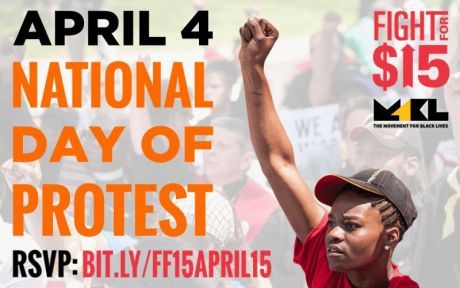Reports
You are here
Fight for $15 and Movement for Black Lives join forces to “fight racism, raise pay!”

April 28, 2017
Forty-nine years after his assassination, Martin Luther King’s dreams of racial and economic justice were championed in the streets of 30 cities across the United States. On April 4, the Movement for Black Lives (a collection of organizations in the #BlackLivesMatter movement) joined together with the Fight for $15 for a national day of action under the banner “Fight Racism, Raise Pay.”
Rallies, buttons worn to work, banner drops and other actions took place in cities such as Detroit, Chicago, Los Angeles, Atlanta, Milwaukee, Denver, Las Vegas, Boston and elsewhere; some restaurants were forced to close temporarily because so many of their workers were participating in the day of action.
In Memphis, Tennesse, a crowd of thousands wound its way through the streets to hold a memorial at the Lorraine Motel, where MLK was killed in 1968 while providing solidarity to the city’s striking sanitation workers—a strike that was precipitated by the deaths of two black workers crushed to death by a malfunctioning garbage truck.
A new coalition
This show of political unity is how the Movement for Black Lives and the Fight for $15 plan to fight and win, regardless of who is in the White House. The election of Trump poses threats to the movements, including a heightened atmosphere of racism and scapegoating, attacks on women and racialized people, and an explicitly pro-corporate, anti-worker agenda. But these threats predate Trump, and these two movements have had to fight Democrats as well.
Branding themselves “The Majority,” the alliance represents a powerful force for the working class. More than 50 per cent of black workers in the US make less than $15 and suffer disproportionately from police harassment, violence, and incarceration. The connection reflects the growing recognition that fighting for racial justice and fighting for economic justice have to be connected to win.
It is also not the first time these groups have come together. In 2014, Michael Brown was shot dead by a white officer in Ferguson, Missouri. The nearly all-black workforce at a neighbourhood McDonald’s had been on strike before the fatal shooting and had gained some organizing skills in the process. They used those skills to join in the incredible protests against the police department and help mobilize others in one of the foundational moments of the electrifying Black Lives Matter movement.
What next?
The Majority, convened by the Movement for Black Lives, are planning to bring together more than 50 partners representing Black, Latino, Indigenous, environmental, LGBTQ, refugee, immigrant, labour and poor people groups for massive protests on May 1, International Workers Day. Launched on the website, beyondthemoment.org, and drawing on MLK’s “beyond Vietnam” speech, the question is posed: “the urgency of this moment calls us to stand together, will you join the fight for freedom, justice and equality?”
The partners involved in the day of action and teachings leading up to the day demonstrate a commitment to racial and economic justice with an emphasis on women’s rights and care for the environment. The importance of this coalition cannot be overstated in the current political climate. The last US presidential election has shown that what is needed to defeat the right-wing populism of Donald Trump and the faux-progressive neoliberalism of the democrats is a politics based on working class demands with racial and gender-based justice at its very centre.
Section:










